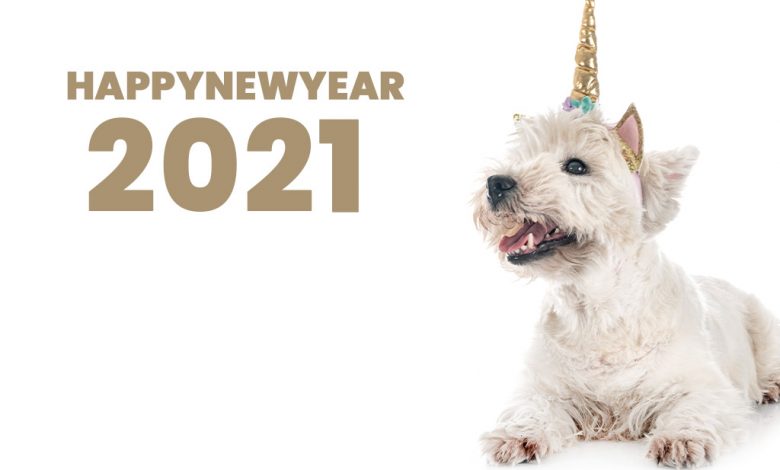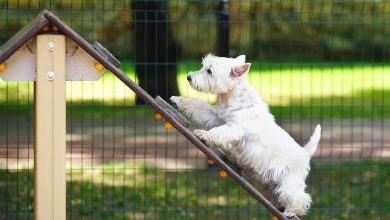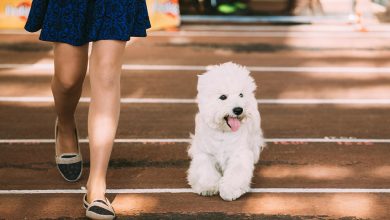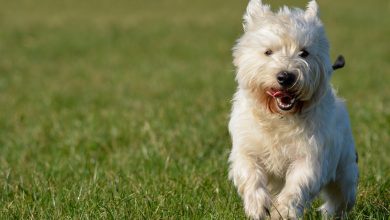New Year, New Routine for your Westie
If you’re not the only one that has put on a few pounds over christmas it may be time to create a fun and healthy new schedule for your best pal.
“Not having enough walks can lead to boredom which in turn can lead to unwanted behaviour such as barking, chewing, over-grooming and toileting in the home”.
“Puzzle games are a great way of keeping your dog alert, and there are many things you can do that are cost-free if you look at your recycling!”
When the clock strikes twelve on New Year’s Eve, it usually seems to bring about positive thoughts on how we have another opportunity to improve our lives for the better. But do we give enough thought to our dog’s well-being too?
All dogs need to have daily walks unless of course they are recovering from injury, surgery or decompressing from a trauma. According to the PDSA, in 2019, research from the PDSA Animal Wellbeing (PAW) report, highlighted that thousands of dogs in the UK have never been walked at all.
Here are some tips to ensure your furry friend loses some extra pounds, gets more active, and enjoys their walks to the best of their ability.
Body Condition
Why not give your dog a once over ‘body condition scoring’ at home. This is the term used by vets to determine a healthy shape for every dog, regardless of breed and size. Observe them from the top and side and they should have an obvious ‘waist’, tucked in and neat. Under the dog’s tummy, there should be no bulge. If you feel along the side of your dog, the ribs, spine, and hips should be obvious to touch but not protruding.
Sniffing
Dogs must be allowed to go for a walk to help relieve stress and keep their brains active. Sniffing is what they do best, and this is also an action to relieve stress. Always give your dog time to sniff as much as they want to, after all, it’s their walk, not yours! Not having enough walks can lead to boredom which in turn can lead to unwanted behaviour such as barking, chewing, over-grooming and toileting in the home.
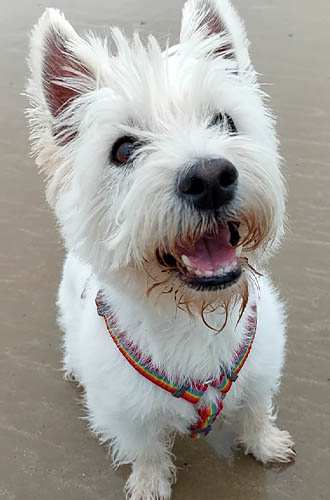
Games and Toys on Walks
If your Westie likes to catch or chase a ball, make sure it’s not small enough for them to swallow. Rings and frisbees are great toys for dogs to run and catch. Sticks should be avoided due to them being able to splinter and cause internal damage to your dog. Some dogs are motivated to carry a toy on walks, such as balls, squeakies and soft toys. This behaviour can certainly help calm them if they are a little nervous of traffic, bikes and sudden noises
Vary your Walks
Just like a ‘couch to 5k’, try speeding your walks up for a short time then slowing to normal pace for a minute or so, then speeding up again. This is a great exercise for both walkers and dogs, it keeps things interesting too. Taking different routes where possible and appropriate for your dog, are always good as your dog will find new smells and get more enrichment from the walk. Changing direction is a great way for your dog to keep interested in its walk and doing this randomly throughout the walk will help your dog to get the most out of the route.
Duration and Frequency
The age, ability, and personality of your Westie will determine the ideal duration and frequency of walks. According to the PDSA, if your dog is a puppy then they should be walked for a ratio of five minutes of exercise per month of age, up to twice daily and when they are fully grown they can go out for much longer. At this point, exercise as much as necessary, and the suggested duration for a Westie by the PDSA is a minimum of 1 hour + daily. For senior dogs, keep the exercise short and gentle but keep walking. Keep the route close to where you started the walk, in case they get tired, and always allow them to have a good sniff! If your dog suffers from dementia, loss of sight, or hearing then it is suggested to keep the walks familiar. If you get home and your dog is still full of energy, then it’s likely that the walk isn’t long enough. However, if your dog is struggling to walk or even reluctant to go then it’s very likely had enough or you may need to reduce the duration, or even change the route.
At-Home Exercise
There are several ways you can exercise your Westie at home. The PDSA suggests that a mobile dog can get a lot of good exercise from being encouraged to climb the stairs and be rewarded with its favourite toy at the top. A plastic hula-hoop can also be used to encourage your dog to walk or jump through. If your dog is less mobile, then some broom handles laid in a row for the dog to step over are good for joints, muscles, and brain function, as is a low sturdy platform such as an exercise step, or low wooden crate.
Running/Hiking
If you are an active person and enjoy running or hiking, why not take your dog too? If it’s an active dog, then it may enjoy going for a jog with you. Exercise would need to be built up gradually otherwise unfit dogs could sustain injuries, just like humans can. Short routes are best to start with.
Flyball and Agility
For those Westies that love to learn and are equally very active, flyball and agility are activities that are rewarding for both owner and dog. Not only will your dog be learning new skills and practicing its obedience, but he/she will be strengthening its bond with you too.
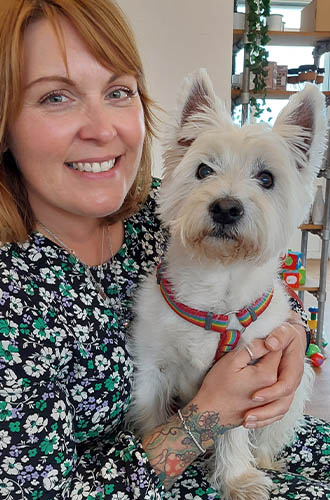
Low Impact Exercise
If you or your Westie struggle to walk far or if your canine pal is recovering from an operation or injury, then there are other things you can do to make sure your dog gets the mental exercise it needs. Puzzle games are a great way of keeping your dog alert, and there are many things you can do that are cost-free if you look at your recycling! Toilet roll inner tubes with a treat hidden inside and the ends folded over are usually very well received, as are boxes filled with newspaper with their favourite toy hidden inside. Another idea is to teach your dog a new trick, whether that be to lay down, shake a paw, or something more elaborate, your dog will enjoy low impact brain training, and this too helps build the bond between you and your dog.
Swimming
Whether you like swimming in the sea or not, your dog may enjoy joining you! Alternatively, a purpose-built dog swimming facility is a great way to help dogs of most ages gain better fitness whilst having fun.
There will always be other points to consider when exercising your dog, such as road safety – make sure you and your dog can be seen with high-viz clothing/lights. Weather is a big factor when out walking, and it’s important to ensure that your dog will be comfortable with the weather conditions. If your dog is frightened of the outside world then a qualified behaviourist may be necessary to help your dog’s anxieties, and if your dog is unwell, then it’s imperative you are mindful of their food quality and quantity while they get less exercise.
Just like many of us wear exercise watches, there are some available for our furry friends. ‘Pitpat’ is a popular dog activity monitor that can easily fit on your dog’s collar or harness. It helps you keep an eye on their activity level, to help manage their weight, and to see what kind of exercise they are getting if in someone else’s care such as kennels/boarders or if in the care of a dog walker. It’s also such a fun way of seeing how many miles your dog has walked!


